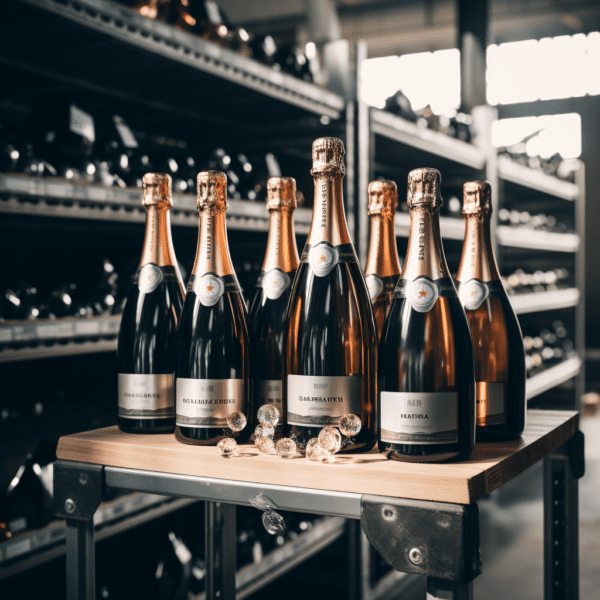
Are you a sparkling wine enthusiast?
Do you savor those effervescent bubbles and the delightful pop when the cork is released?
If so, you know that sparkling wine is not just a beverage; it’s a celebration in a bottle.
But to fully enjoy it, you need to master the art of storing sparkling wine.
In this comprehensive guide, we’ll walk you through the best practices for preserving the quality and flavor of your favorite bubbly.
From unopened bottles to that half-finished celebratory glass, we’ve got you covered.
Storing Unopened Sparkling Wine
The Cork’s Role in Longevity
When it comes to storing sparkling wine, the first rule is to keep cork-closed bottles on their side.
Why? Because this simple act keeps the cork moist, preventing it from drying out and shrinking.
A shrunken cork can allow oxygen in and carbon dioxide out, ultimately ruining the wine’s fizz.
But there’s more to it than just cork preservation.
Storing your sparkling wine on its side also keeps the headspace near the top of the wine.
Ullage or headspace (the amount by which a container falls short of being ful), formed during bottling, helps mature the wine’s flavors slowly, enhancing its overall quality.
Maintaining Stability
For storing sparkling wine long-term, stability is paramount.
Vibrations can be detrimental, altering acid and alcohol levels, which can result in some sour experiences and other undesirable changes.
Therefore, avoid storing your precious bottles in standard refrigerators, as these appliances tend to vibrate.
Instead, opt for a stable environment.
Managing Light and Humidity
Light levels and humidity play pivotal roles in preserving sparkling wine.
Exposure to sunlight, particularly its UV rays, can affect the amino acids in the wine in a negative way, leading to unwanted sulfurous notes akin to cabbage.
To prevent this, store your sparkling wine in a cool, dark place away from direct sunlight.
When it comes to humidity, maintaining levels between 50-85% is ideal.
This range ensures that the cork remains moist but not so moist that it fosters mold growth.
Striking the right balance is key to long-term storage success.

Temperature: The Key Factor
Perhaps the most critical aspect of sparkling wine storage is temperature.
Standard refrigerators are often too cold for unopened bottles of sparkling wine.
The sweet spot for storing your bubbly is between 10 and 13 °C (50-55 °F).
This temperature range is typically found in special wine fridges or a well-maintained wine cellar.
By following these guidelines for unopened sparkling wine, you can ensure that each bottle reaches its full potential when you finally uncork it.
Storing Screw-Top Sparkling Wines
Screw Tops: A Different Approach
If you have a bottle of sparkling wine with a screw top, the rules differ slightly.
Screw-top sparkling wines are less affected by humidity and bottle orientation.
You can store them upright with little concern for humidity levels.
However, don’t forget the importance of temperature control, which remains crucial for preserving the quality of the wine.

Storing Sparkling Wine After Opening
Preserving Opened Sparkling Wine
Opened sparkling wine has a shorter shelf life, so it’s essential to preserve it properly.
If you can’t finish a bottle in one go, get yourself a quality champagne stopper.
These stoppers help prevent carbonation loss, ensuring your next glass is as bubbly as the first.
Remember to keep the opened bottle cold at all times.
Heat accelerates carbonation loss, so room temperature is a no-go.
Ideally, consume the opened sparkling wine on the same day or within 3-4 days to enjoy it at its best.
Determining Sparkling Wine’s Freshness
Signs of Expired Sparkling Wine
Wondering if your sparkling wine has gone bad?
There are telltale signs to look for.
Odor
A suspicious or unpleasant smell is a clear indication that the wine has expired.
It might even smell medicinal or vinegary, or oddly like burnt rubber.
Taste
Take a small sip (but don’t swallow).
If you detect sour notes or a sharp vinegary taste, the wine has gone off.
Watch out for horseradish-like or caramelized flavors as well.
Color
Obvious color changes signal chemical alterations in the wine.
If you notice such changes, it’s time to bid farewell to that bottle.

Unopened Sparkling Wine’s Lifespan
Even unopened sparkling wine has a lifespan, albeit a longer one.
Typically, it can be enjoyed 2-3 years past its recommended drinking window.
High-quality Champagne and traditionally made sparkling wines can last even longer, up to a decade or more.
However, the key factor determining the longevity of unopened sparkling wine is the storage conditions it’s been subjected to.
In conclusion, storing sparkling wine is both an art and a science.
By following these guidelines, you can ensure that each bottle of sparkling wine you open is a cause for celebration.
Whether it’s preserving the cork, managing stability, or understanding the impact of light, humidity, and temperature, these tips will help you make the most of your sparkling wine experience.
Remember, each bottle of sparkling wine has its own story to tell, and it’s up to you to preserve and savor it to the fullest.
Cheers to the perfect pop and the joy of sparkling wine!
FAQ:
Q1: Can I store sparkling wine in a standard refrigerator?
A1: Standard refrigerators are generally too cold for unopened sparkling wine.
It’s best to store it in a cool, dark cupboard or a dedicated wine cellar with the right temperature range.
Q2: What if my sparkling wine has a screw top? Do I still need to store it upright?
A2: If your sparkling wine has a screw top, you can store it upright with less concern for humidity and orientation.
However, maintaining the right temperature is crucial.
Q3: How long does opened sparkling wine last?
A3: Opened sparkling wine should ideally be consumed on the same day or within 3-4 days.
Using a champagne stopper and refrigeration can help preserve its carbonation.
Q4: Can unopened sparkling wine expire?
A4: Unopened sparkling wine can last beyond its recommended window, typically 2-3 years.
High-quality varieties may last up to a decade or more, depending on storage conditions.







